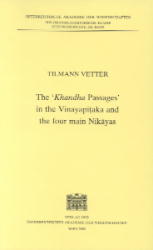
Dieses Buch erfaßt alle Stellen in den ersten Teilen
des Pali-Kanons, die sich auf die Lehre von fünf
„Zweigen” einer Person beziehen, von denen man
sich distanzieren soll. 449 Stellen, welche die
Begriffsreihe rupa, vedana, san~n~a, san.khara und
vin~n~ana (übersetzt mit „body”, „feeling”, „ideation”,
„impulses” and „sensation”) enthalten oder auf sie
mittels der Begriffe upada nakkhandha oder khandha
hinweisen, sind registriert und, soweit es sich nicht
um Wiederholungen handelt, kritisch ediert und mit
einer englischen Übersetzung versehen. Wo der
Kontext es erlaubt, wird die soteriologische Funktion
der Lehre beschrieben; wo bekannt, werden Parallelen
in Sanskritfragmenten und chinesischen und tibeti-
schen Übersetzungen genannt.
Die lange Einleitung weist auf Möglichkeiten hin,
verschiedene Formulierungen dieser Lehre historisch
zu ordnen, und erklärt die fünf Begriffe rupa usw., ins-
besondere den schwierigen Begriff san.khara.
Appendix 1 zeigt, in welchen Passagen man die
nur sporadisch vorkommenden Begriffe upadanakkhandha oder khandha findet, und wo eine Person genannt ist, welche sich vom Körper, usw. distanzieren soll (ca.60% aller Stellen), wo nur vom Abstandnehmen gesprochen wird, ohne daß eine
Person genannt wird (ca.40%), und wo die Existenz
einer Person geleugnet wird (1 Stelle). Appendix 2
zitiert, mit englischen Übersetzungen, die wenigen Spuren, die sich von dieser Lehre in den Verstexten des fünften Nikaya finden (keine im Suttanipata!). Appendix 3
registriert stereotype Ausdrucksweisen, und Appendix 4 enthält einen Index alter Namen und Termini.
…
This book investigates all passages in the first parts of the Pali canon that refer to the teaching of the five “branches” of a person that should be distanced. 449 passages mentioning the series rupa, vedana, san~n~a, san.khara and vin~n~ana (translated as “body”, “feeling”, “ideation”, “impulses” and “sensation”) or hinting at them by means of the terms upada nakkhandha or khandha are recorded. All passages that are not repetitions are critically edited and translated into English. If the context allows, remarks on their soteriological function are made; if available, parallels in (hybrid) Sanskrit fragments, Chinese and Tibetan translations are referred to or quoted.
The long introduction points to possible historical arrangements of different formulations of this teaching and discusses the meaning of the five terms rupa, etc, with special emphasis on san.khara. Appendix 1 shows where the terms upadanakkhandha or khandha can be found and whether a passage refers to a person that should distance the five items (ca.60% of the passages), or only speaks of distancing without mentioning a person (ca.40%), or denies the existence of a person (1 passage). Appendix 2 quotes, with English translations, the few traces of this teaching in the verse texts of the fifth Nikaya (none in the Suttanipata!). Apendix 3 refers to stereotype formulas and Apendix 4 contains ancient names and terms.
978-3-7001-2932-5
352 Seiten,
24x17cm, broschiert